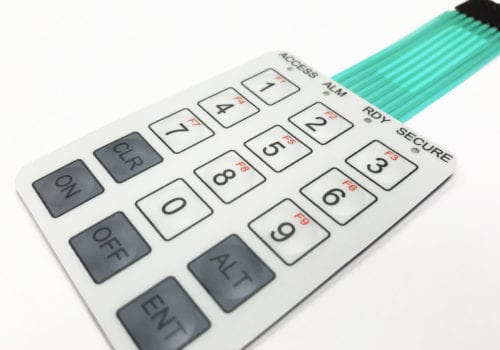Discover Just How a Membrane Switch Boosts Toughness and Performance in Gadget
Comprehending the Capability of Membrane Changes for Customer User Interface Gadget
The functionality of membrane switches over stands for a significant improvement in individual interface style, incorporating performance with visual convenience. As markets increasingly prioritize individual experience, understanding the nuances of membrane button modern technology ends up being necessary.
What Are Membrane Buttons?
Membrane buttons are innovative interface devices that promote user communication with digital devices. These versatile parts are composed of numerous layers, consisting of a graphic overlay, spacer, and a published circuit layer. The layout enables a smooth integration into various digital gadgets, enhancing both the aesthetic and practical facets of interface.
Membrane layer buttons are frequently used in a vast array of applications, from home home appliances to industrial machinery and medical tools. Their building and construction generally includes a thin profile, making them a perfect selection for small layouts. The responsive feedback offered by these switches can be engineered to meet particular user preferences, ensuring efficient interaction in between the user and the tool.
Toughness is one more considerable advantage of membrane layer buttons, as they are immune to dirt, dampness, and chemicals, which boosts their lifespan sought after settings. Furthermore, these buttons can be customized in terms of form, dimension, and graphic style, permitting branding and user-specific features. In general, membrane layer switches represent a sensible option for enhancing customer experience in digital tools, combining functionality with visual charm in a reliable way.
How Membrane Switches Over Job
Operating on a simple concept, membrane layer switches make use of a split construction to register individual input successfully. Each switch contains several layers, including a printed circuit layer, a spacer layer, and a leading visuals layer, which are made to function with each other effortlessly. When a user presses the leading layer, it compresses the spacer layer, bringing the conductive elements of the circuit layer into call with each various other.
This get in touch with creates a closed circuit, signifying the device to perform a certain feature. The style permits various setups, consisting of tactile responses, which can boost the user experience by giving a physical feeling upon activation. The materials utilized in membrane buttons typically include adaptable substratums, such as polyester or polycarbonate, which ensure longevity and durability against deterioration.

Trick Benefits of Membrane Buttons

Another substantial advantage is their compactness. Membrane switches are thin and light-weight, which enables makers to conserve room in their devices without sacrificing performance. This feature is particularly helpful in applications where weight and quantity are essential considerations.
Furthermore, membrane switches are resistant to dirt, moisture, and chemicals, enhancing their sturdiness. This durability extends their life-span and lowers the requirement for frequent replacements, leading to expense financial savings over time.
Furthermore, the tactile responses offered by membrane layer buttons can be enhanced to boost customer interaction. They can include functions such as raised switches or distinct clicks, improving use and user experience.
Applications Throughout Industries
User user interface devices making use of membrane buttons are widespread in a vast range of industries, showcasing their versatility and capability. Membrane why not look here Switch. In the clinical market, membrane switches are integral to devices such as diagnostic devices and individual surveillance systems, where their durability and simplicity of cleaning are critical for preserving hygiene requirements. Likewise, in the vehicle market, these buttons are utilized in dashboard controls and infomercial systems, giving a sleek and contemporary user interface for individuals.
Additionally, the customer electronic devices sector advantages from membrane layer switches in appliances and portable tools, where portable style and user-friendly user interfaces boost customer experience. Industrial applications additionally take advantage of membrane switches for control board in equipment and automation systems, highlighting their toughness and resistance to extreme environments.
In the aerospace and protection markets, membrane layer switches are used in cockpit controls and tools, where integrity and efficiency under severe conditions are critical. In addition, the pc gaming market progressively incorporates membrane layer buttons in controllers and game makers, adding to an appealing individual experience. In general, the flexibility of membrane switches allows their prevalent usage throughout various industries, highlighting their significance in modern individual interface design.
Future Fads in Membrane Layer Switch Over Modern Technology

Furthermore, the usage of innovative materials, such as polycarbonate and polyester movies, is expected to increase, offering boosted sturdiness and resistance to anchor ecological stress factors. These products add to the total longevity of membrane switches, making them appropriate for harsher industrial applications.
Furthermore, the incorporation of wise innovation, consisting of IoT connectivity, will certainly allow membrane layer buttons to interact with various other devices and systems, helping with an extra interactive user experience. This fad lines up with the expanding need for wise gadgets throughout different markets, from healthcare to consumer electronic devices.
Finally, personalization choices are prepared for to broaden, permitting makers to develop bespoke solutions tailored to particular customer needs and preferences. These developments will position membrane buttons as vital components in the advancement of user interface modern technology.
Final Thought
In final thought, membrane layer switches over represent a pivotal advancement in customer interface innovation, using a trusted and functional remedy for varied digital applications. As developments in product science and touch noticing modern technologies proceed, the functionality and applicability of membrane buttons are expected to increase, enhancing their significance in contemporary electronic gadgets.